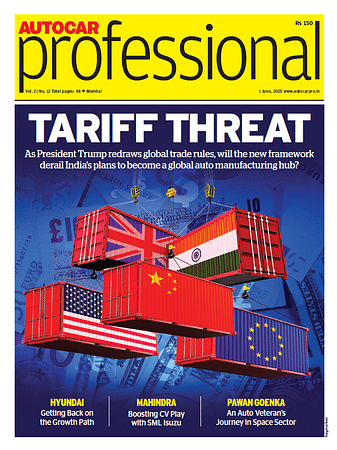Aluminium - Strong Substitute In Lightweighting, Says Vedanta Aluminium CMO Alok Ranjan
As automakers prioritize lower emissions and better fuel economy, its integration into non-load-bearing components is accelerating.
The automotive industry is looking for more efficiency and sustainability with a focus on lightweighting for better fuel efficiency, lower emissions and improved performance. Aluminium is emerging as a critical enabler for lightweighting, an alternative to steel particularly on non-load-bearing parts.
Lightweighting has become a necessity with its ability to reduce costs, enhance fuel efficiency and lower carbon emissions, according to Alok Ranjan, Chief Marketing Officer of Vedanta Aluminium, who was speaking at the Autocar Professional’s Vehicle Lightweighting Webinar.
“Aluminium, with two-thirds the density of steel, is highly durable, corrosion-resistant, and infinitely recyclable, making it a very strong substitute for various parts of an automobile,” Ranjan said.
Aluminium offers a great advantage in vehicle lightweighting, being significantly lighter than steel. Its lower weight directly improves fuel economy and lowers emissions, making it a compelling choice for OEMs and advanced vehicle designs. Aluminum enables manufacturers to produce more efficient vehicles without compromising on performance or safety.
Vedanta Aluminium, India’s largest aluminum producer and among the top six globally, is at the forefront of this transition. The company has an annual capacity of nearly 3 million tonnes of aluminum, with over 700 kilotonnes dedicated to automotive-grade alloys.
With the launch India's first primary foundry alloy (PFA) for alloy wheels in 2019, Vedanta has become a leading supplier to the automotive industry, providing materials for wheels, engine blocks, and a growing range of EV components.
The company offers three products from aluminium which goes into various components of an automobile - PFA which goes into alloy wheels, pellets which go into making extrusion for body parts and then mold products which can go into sheets in various parts of the automobile.
Ranjan noted that the properties of aluminium – infinitely recyclable, highly durable, and corrosion resistant - translate into significant benefits for vehicle manufacturers and consumers alike, and makes it an important source of lightweighting. Lightweighting through aluminum can lead to a 4-5% reduction in carbon emissions, a 22% mass saving, and roughly a 5% reduction in cost per mile, he added.
“When we talk about speed or acceleration, which is also an important criterion, aluminum vehicles have far better pickup and acceleration. Thanks to the lower mass, there is an edge. Also since it is durable, recyclable and corrosion resistant, the cost of maintenance is typically on the lower side, it could be 10-15% lower as compared to its alternative,” Ranjan said.
When it comes to battery performance, he said aluminum offers significant benefits there as well. “When we look at the battery life, aluminum usage results in much lesser frequent charging cycles and much better longevity of the battery. This is especially important as energy storage becomes an important criterion.”
Though aluminum may present a higher upfront material cost compared to steel, Ranjan emphasized the importance of looking at the total cost of ownership. Considering its positive impact on fuel economy, reduced maintenance needs, extended battery life, and higher resale or salvage value due to its recyclability, aluminum presents a more economically favorable choice.
Going forward, Ranjan sees strong growth potential for aluminum. Right now, per capita consumption of aluminum in India is one eight despite being the third largest car maker. Aluminum usage per vehicle in India is 70-80% of global standards. However, government policies focusing on cleaner and efficient vehicles provide a significant growth potential.
“So, there is a policy push, there is a sustainability push. And if we rely on the data coming from other countries like China or the West, we see significant growth in terms of EVs which again means up to 80 kgs per vehicle more aluminum usage,” he added.
According to Ranjan, the requirement of aluminum in India is at around 6 million tonnes per annum, while the current capacity is around 4 million tons. Vedanta Aluminium is augmenting its capacity to around 5 million tons.
RELATED ARTICLES
Hot Stamping is India’s Smart Route to Lightweight, Cost-Effective EVs: Gestamp’s Sachin Bhoutkar
Advanced hot stamping and giga stamping offer cost-competitive alternatives, but early OEM collaboration is key, says R&...
AI’s Biggest Contribution to Automotive Development Will Be Reducing Turnaround Times: Tata Technologies
Artificial intelligence is transforming vehicle engineering by accelerating design automation and reducing development t...
Toyota Kirloskar Motor Launches 3-Month EMI Holiday Scheme for Glanza and Hyryder Models
Customers can purchase vehicles immediately and begin EMI payments during Navratri season.





 By Kiran Murali
By Kiran Murali
 12 Jun 2025
12 Jun 2025
 896 Views
896 Views





 Shahkar Abidi
Shahkar Abidi



 Shruti Shiraguppi
Shruti Shiraguppi

